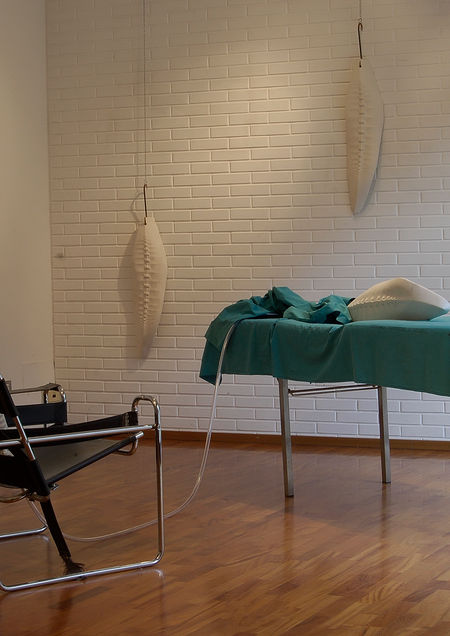Take Care
Mixed technique
Work presented at 56° Venice Biennal 2011
Sala Nervi Torino
.jpg)
Written by Cinzia Cesana
In front of us a scene, like a blocked frame of a film without sound: a chair, a hospital bed, a patient and somebody who takes care of them, spectators on the walls. They are not people but part of them carved. The upright vertical spine on the chair assists the back lying on the couch: Take care. In the installation presented by the artist concur several elements perfectly fused together. There is the sculptural part, the more traditional one, which comes from the experience of sculpting and in the relationship with the material. It is the element where the aesthetic part dominates. The shapes are beautiful, harmonious, smooth, cured and made so well that they look like anatomical molds. But thery are not. They are the result of the study of anatomy where the real form is transfigured and mixed with natural forms: the succession of vertebrae that defines the dorsal column turns into the back into an overlapping of small leaves... the extended back is actually a large elongated leaf, whose veins draw the human anatomy. Gerbi's research confirms to be oriented not to renounce the classical material and the work of sculpting, which from the last few years draws its main inspiration from the observation of nature, especially the elongated and sinuous forms of branches, leaves and roots, often merged with the forms of the human body. But the sculpture here is not alone, there is the setting that transforms it into an installation: the hospital bed, the green sheet, the doctor's chair, other elements, hung as spectators of the scene, witnesses of the moment. From their admixture, the third element of the work: the somewhat disturbing atmosphere, rich in subtle suggestions, sometimes contradictory and enigmatic. Assistant, assisted and spectators are bound by a straw that unites their destinies and makes them dependent on each other. The extended position of the back suggests the need for rest, for abandonment, for a support that no longer holds up, perhaps a gesture of modesty in the partial covering with the sheet. In front of the straight spine, firm of those who must bring help, of those who must take care. But care is attention, consolation or persistence? In those cold lane objects there is something painful, perhaps the idea of the disease that overcomes humanity, involving and marking in the same way those who care and those who are cared for, perhaps the synthesis of the contemporary evils that breathe suffering in an attempt to find and recompose a body in at least some of its parts.In front of us a scene, like a blocked frame of a film without sound: a chair, a hospital bed, a patient and somebody who takes care of them, spectators on the walls. They are not people but part of them carved. The upright vertical spine on the chair assists the back lying on the couch: Take care. In the installation presented by the artist concur several elements perfectly fused together. There is the sculptural part, the more traditional one, which comes from the experience of sculpting and in the relationship with the material. It is the element where the aesthetic part dominates. The shapes are beautiful, harmonious, smooth, cured and made so well that they look like anatomical molds. But thery are not. They are the result of the study of anatomy where the real form is transfigured and mixed with natural forms: the succession of vertebrae that defines the dorsal column turns into the back into an overlapping of small leaves... the extended back is actually a large elongated leaf, whose veins draw the human anatomy. Gerbi's research confirms to be oriented not to renounce the classical material and the work of sculpting, which from the last few years draws its main inspiration from the observation of nature, especially the elongated and sinuous forms of branches, leaves and roots, often merged with the forms of the human body. But the sculpture here is not alone, there is the setting that transforms it into an installation: the hospital bed, the green sheet, the doctor's chair, other elements, hung as spectators of the scene, witnesses of the moment. From their admixture, the third element of the work: the somewhat disturbing atmosphere, rich in subtle suggestions, sometimes contradictory and enigmatic. Assistant, assisted and spectators are bound by a straw that unites their destinies and makes them dependent on each other. The extended position of the back suggests the need for rest, for abandonment, for a support that no longer holds up, perhaps a gesture of modesty in the partial covering with the sheet. In front of the straight spine, firm of those who must bring help, of those who must take care. But care is attention, consolation or persistence? In those cold lane objects there is something painful, perhaps the idea of the disease that overcomes humanity, involving and marking in the same way those who care and those who are cared for, perhaps the synthesis of the contemporary evils that breathe suffering in an attempt to find and recompose a body in at least some of its parts.







